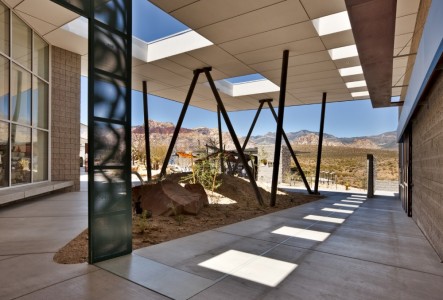
Red Rock Canyon Visitor Center - Line and Space - US
Architect: Line and Space, LLC
Location: Las Vegas, Nevada, US
Completion Date: 2011
Project Area: 52,700 Ft²
Client: US Department of the Interior Bureau of Land Management
Contractor: Straub Construction
Structural Engineer: Holben, Martin, and White Consulting Structural Engineers
Civil Engineer: GLHN Architects and Engineers
Exhibit/Interpretive Consultant: Hilferty and Associates
Photography: Robert Reck, Henry Tom
Intended to introduce up to 1,000,000 visitors a year to the wonders of Red Rock Canyon, the new Interpretive Facility differs from traditional visitor centers by emphasizing the specific attributes of Red Rock Canyon itself, in lieu of pseudo-natural imitations. Here, visitors are introduced to the relevant science, art and culture that will enhance their experience in the Canyon; then are strongly encouraged to visit the nearby real thing.
The Visitor Center responds to its environment – transition zones alleviate shock to users’ senses. Controlling exposure to the sun provides shaded, cooler microclimates for outdoor exhibits and activities. Like the desert tortoise burrowing to regulate its body temperature, earth integration of the building insulates, and also conveys a message of resource conservation.
In support of the Bureau of Land Management’s (BLM) mission to encourage stewardship for the land, the design of this facility provides an outdoor experience which will instill, in individuals, a sense of personal responsibility for their land’s well-being. Many resource-conserving ideas are incorporated into the project. The Arrival Experience is sheltered by a “big hat” (a roof with ample overhangs), which creates intermediate thermal transition zones, as well as forms the collection plane for rainwater harvesting (used for interpretive exhibits and landscape irrigation).
High-efficiency mechanical systems are utilized, while daylighting, solar water heating, a transpired solar wall system and a 55 kw photovoltaic array convert the region’s intense sun into free energy. The transpired solar wall provides required heating for the rest rooms, and eliminates the need for a mechanical system in these spaces. As part of future upgrades to infrastructure, a new recirculating waste water system will replace an existing septic system, treating reclaimed water for reuse in flushing toilets.
The project anticipates LEED Silver certification from the USGBC.
- Red Rock Canyon Visitor Center – Line and Space – US
- Red Rock Canyon Visitor Center – Line and Space – US
- Red Rock Canyon Visitor Center – Line and Space – US
- Red Rock Canyon Visitor Center – Line and Space – US
- Red Rock Canyon Visitor Center – Line and Space – US
- Red Rock Canyon Visitor Center – Line and Space – US
- Red Rock Canyon Visitor Center – Line and Space – US
- Red Rock Canyon Visitor Center – Line and Space – US
- Red Rock Canyon Visitor Center – Line and Space – US
- Red Rock Canyon Visitor Center – Line and Space – US
- Red Rock Canyon Visitor Center – Line and Space – US
- Red Rock Canyon Visitor Center – Line and Space – US
- Red Rock Canyon Visitor Center – Line and Space – US


















No Comments